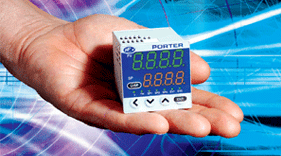Mass Flow Controllers, also known as MCFs, are incredibly useful in the measurement and control of liquids and gases. This is why they are often employed across a wide range of applications, including semiconductors and laboratory applications, as they enable low-flow accuracy, repeatability and relative immunity to temperature and pressure fluctuations; even in the inlet flow.
Read on to find out everything there is to know about Mass Flow Controllers, how they work and why you need to use one in your application.
What is a Mass Flow Controller?
Put simply, a Mass Flow Controller, also known as an MFC, is a device that is used to measure and control the flow of liquids and gases in an application. Here, the MFC is employed to control a specific type of liquid or gas at a very particular range of flow rates.
This means that a Mass Flow Controller is usually given a set point from 0% to 100% of its full range to control the flow of a liquid or gas, however they are typically operated between 10% and 90% of their full scale range. Here, the highest level of accuracy is achieved.
What are the features of a Mass Flow Controller?
Despite being limited in parts, a Mass Flow Controller is a sophisticated piece of equipment! All Mass Flow Controllers have an inlet port, an outlet port, a mass flow sensor and a proportional control valve.
These features work together to control and measure the flow of a liquid or gas within an application as part of a closed loop control system. Here, the closed loop control system is given an input signal by the operator, or a computer system, that will then compare the value being fed from the Mass Flow Sensor. The Mass Flow Controller will then adjust that proportional value accordingly to achieve the required flow.
What is the operating principle of a Mass Flow Controller?
A Mass Flow Controller operates on 5 basic principles. These are:
- The gas, or liquid, enters from the inlet and splits to flow past the Mass Flow Sensor or through the bypass pipe.
- If the gas or liquid flows past the sensor, the Mass Flow Rate is detected as a proportional change in temperature converted by the bridge circuits to the electrical signal.
- This signal then passes through the amplification and correction circuits, to be output as a linear voltage between 0 and 5V. This signal is also sent to the comparison control circuits.
- The comparison control circuit compares the flow rate setting signal and the actual flow setting signal from the sensor, sending the difference to the valve driving circuit.
- The flow rate control valve will move as appropriate to make the difference between the required flow set point and the flow output approach zero. This ensures that the flow is controlled so it is always at the required flow rate.
Why do you need to use a Mass Flow Controller?
Mass Flow Controllers are obviously very important when it comes to controlling the flow of liquids and gases, but we also think they have five key purposes. These are:
- Mass Flow Controllers are a fantastic thermal measurement solution for all high-flow rates of gases. This is because they enable the gas to be measured by way of thermal by-pass measurement. Additionally, inline measurement is available in a wide array of measurements, from a few ml/minute up to hundreds of thousands of m3/hour – or maybe even more!
- Compared to traditional thermal mass flow meters, a Mass Flow Controller is far less sensitive to humidity and contamination, meaning they are up to the challenges laid out by much more difficult applications and environments.
- Mass Flow Controllers feature a compact and robust design that gives them excellent repeatability and performance. This also makes them extremely versatile and means that they can be used in a variety of applications and industries.
- Mass Flow Controllers feature an inline measurement concept that makes it possible to build and calibrate your instrumentation devices with air or nitrogen.
- The amount of pressure lost over the instruments is usually quite negligible as it does not vary from the amount of pressure loss from being transported in a straight pipe.
Mass Flow Controllers from leading brands
There are a number of brands who specialise in the manufacture of gas and liquid control devices, such as Mass Flow Controllers. One such example is Malema, who offer a range of MFC devices based on Coriolis and Ultrasonic flow measure technologies. Their patented Coriolis flow sensor is immune to changes in fluid conditions, such as density or viscosity, which makes it suitable for a range of applications.
Additionally, Burkert offers a range of compact Mass Flow Controllers, used to control a range of gases with a pre-set flow rate reference value that does not alter regardless of disturbance variables. Another example of powerful MFC are those made by Porter. These MFCs deliver extremely quick response times and are available in a range of configurations to satisfy the demands of a lot of different applications.
If you want to learn more about Mass Flow Controllers and how to integrate these into your application, why not speak to fluid and gas control experts; Fluid Controls? Their expert team is on hand to explain to you all the benefits of MFCs and how to design a suitable system for your application.

